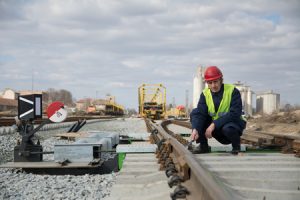[breadcrumb]
How Can a Railroad Inspector Get Mesothelioma by Occupational Exposure to Asbestos?
Railroad inspectors inspect equipment or goods that are transported on trains. They may inspect freight, rails and transportation vehicles to ensure that freight trains are safe to transport people and/or cargo and to ensure trains travel on schedule.
Railroads were once the most common form of transportation and transporting goods across state lines. More than 300,000 miles of track are spread across the United States that were operate, built, inspected, maintained and repaired by workers.
Railroad inspectors inspect rails, roadbeds and railroad ties. They also check for problems on the rails. Asbestos was used to manufacture train parts from the 1930s to the 1970s, so inspectors who looked after these parts could have been exposed to asbestos. Often, asbestos was included in public driving cabins, carriages, floor tiles, wallboards, floor tiles and other construction materials, providing additional potential points of exposure.
Common job duties of railroad inspectors include:
- Inspect railroad equipment according to federal regulations
- Examine railroad equipment for damage
- Inspect the mechanical condition of trains
- Make adjustments to the mechanical condition of locomotives
- Investigate customer complaints regarding safety concerns
Locations in the United States for the Highest Employment Rates for Railroad Inspectors
According to the United States Bureau of Labor Statistics, there are currently 30,030 transportation inspectors currently employed in the United States. 4,380 of these workers work in the rail transportation industry. States with the highest employment rates for railroad inspectors include:
- New York
- Texas
- California
- Georgia
- Florida
Similar Occupations as Railroad Inspectors
Similar occupations as railroad inspectors include:
- Bus drivers
- Delivery truck drivers and driver/sales workers
- Hand laborers and material movers
- Heavy and tractor-trailer truck drivers
- Material moving machine operators
- Quality control inspectors
- Water transportation workers
Lawsuits and Settlements Involving Railroad Inspectors and Mesothelioma
There have been several lawsuits brought by former railroad workers who were exposed to asbestos. For example, in 2006, the widow of a railroad worker was awarded a $7.4 million verdict against CSX Transportation after the jury found that the company failed to conduct air sampling for asbestos hazards until 1980 and a later air sampling report showed that asbestos dust was in excess of safe levels when asbestos siding was cut with a saw. The man worked for the company from 1962 to 1999, often around craftsmen who repaired and demolished areas containing asbestos.
Railroad workers who develop an occupational illness do not generally have access to the workers’ compensation claim. Instead, they must file a claim under the Federal Employers Liability Act. To receive compensation under this law, an injured railroad worker is required to prove the employer’s negligence contributed to the injury and the railroad company operates in multiple states. If the railroad only operates in a single state, the injured victim may be able to sue manufacturers of asbestos-containing products that the victim was exposed to.
Studies Related to Asbestos and Railroad Inspectors
There are several studies that have been conducted that explore the link between railroad workers and asbestos exposure. The Department of Medicine of Brigham and Women’s Hospital entitled “Past exposure to asbestos among active railroad workers” compared the health risks of railroad workers who worked on steam-powered trains and those that worked on diesel-powered trains. Researchers evaluated surveys of 514 white male railroad workers. They found that 21% of the workers who were 50 years old or older had likely exposure to asbestos, 3% of those younger than 50 years old had likely asbestos exposure and that exposure to older workers was usually short in duration.
A 2015 study conducted on Belgian railroad workers found that railroad workers were more than three times more likely to die of mesothelioma, compared to the general population.
Types of Asbestos Products Used by Railroad Inspectors
Railroad Inspectors could have been exposed to a variety of asbestos-containing materials, such as:
- Insulation
- Sealing cement
- Cement ties
- Gaskets, valves and pumps
- Brake pads and brake linings
- Clutches and clutch plates
- Plaster
- Wallboards
- Ceiling and floor tiles
- Boiler linings and housing casings
- Fireproofing materials in engine rooms
- Hydraulic and steam supply line hoses
- Sealants and paints
- Packing, rope and cement supplies
- Soundproofing materials
Manufacturers of Products Used by Railroad Inspectors
Railroad inspectors may have been exposed to asbestos from any of the following companies and manufacturers which have been involved in asbestos litigation:
- Aberdeen
- Allied Signal Corporation
- Amtrak
- P. Green
- Armstrong Cork
- Asbestos Manufacturing Co.
- Asbestos Textile Co.
- Bendix
- Birmingham Southern Railroad Company
- BNSF Railway Co.
- Carolina & Western Railway Co., Inc.
- CertainTeed Products
- Celotex
- Chesapeake and Ohio Railway Company
- Conrail
- CSX Transportation
- Eagle-Picher
- Elgin, Joliet & Eastern Railroad Co.
- Eternit
- Federal-Mogul
- Ferodo
- Flintkote Co.
- GAF Corporation
- Georgia Pacific
- Gatke Corp.
- Genesee & Wyoming Inc.
- Harbison-Walker
- K. Porter, Inc.
- Illinois Central Industries, Inc.
- Iowa Interstate Railroad, Ltd.
- Johns Manville
- Kansas City Southern Railway Company
- Keasbey & Mattison’s Bell Asbestos Mines
- Metro-North Commuter Railroad Co.
- National Gypsum
- Norfolk Southern
- Owen-Corning Fiberglas Corp.
- Rapid American
- Raybestos-Manhattan
- Seminole Gulf Railway LP
- Watco Transportation Services, Inc.

